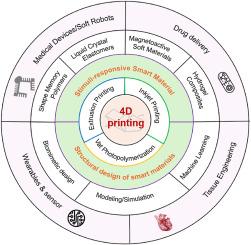Recent advances in polymer 4D printing: 3D printing techniques, smart material design, and healthcare applications
Q1 Engineering
引用次数: 0
Abstract
Fourth-dimensional (4D) printing has progressed tremendously since its first conceptualization in 2013. 4D printing is an emerging branch of three-dimensional (3D) printing that allows printed parts to change their shapes and properties as a function of time under external stimuli. It has revolutionized the fabrication of smart polymer composites with customized geometry and programmed dynamic functions for expanding engineering and healthcare applications. This review provides a comprehensive overview of recent advances in the 4D printing of polymer composites, emphasizing three pivotal areas: 3D printing methodologies, smart material design, and their healthcare applications. We start with 3D printing techniques, encompassing traditional methods, multimaterial printing approaches, and other emerging technologies for functional polymer systems. We discuss the molecular engineering of shape-shifting smart polymers, including shape memory polymers, liquid crystal elastomers, magnetoactive soft materials, and hydrogel composites. The structural design strategies and modeling-guided design of smart materials are also covered. We summarize the emerging healthcare applications of 4D-printed polymer composites in medical devices, soft robotics, wearables, drug delivery, and tissue repair/regeneration. Finally, challenges, opportunities, and future directions are highlighted in material design and printing techniques for 4D printing to advance next-generation healthcare solutions.

聚合物4D打印的最新进展:3D打印技术、智能材料设计和医疗保健应用
自2013年首次概念化以来,四维(4D)打印已经取得了巨大的进步。4D打印是三维(3D)打印的一个新兴分支,它允许打印部件在外部刺激下随时间改变其形状和特性。它彻底改变了智能聚合物复合材料的制造,具有定制的几何形状和可编程的动态功能,用于扩展工程和医疗保健应用。本文综述了聚合物复合材料4D打印的最新进展,强调了三个关键领域:3D打印方法、智能材料设计及其在医疗保健领域的应用。我们从3D打印技术开始,包括传统方法、多材料打印方法和其他功能聚合物系统的新兴技术。我们讨论了可变形智能聚合物的分子工程,包括形状记忆聚合物、液晶弹性体、磁活性软材料和水凝胶复合材料。本文还讨论了智能材料的结构设计策略和建模指导设计。我们总结了3d打印聚合物复合材料在医疗设备、软机器人、可穿戴设备、药物输送和组织修复/再生方面的新兴医疗应用。最后,挑战,机遇和未来的方向强调了材料设计和打印技术的4D打印,以推进下一代医疗保健解决方案。
本文章由计算机程序翻译,如有差异,请以英文原文为准。
求助全文
约1分钟内获得全文
求助全文
来源期刊

Smart Materials in Medicine
Engineering-Biomedical Engineering
CiteScore
14.00
自引率
0.00%
发文量
41
审稿时长
48 days
 求助内容:
求助内容: 应助结果提醒方式:
应助结果提醒方式:


